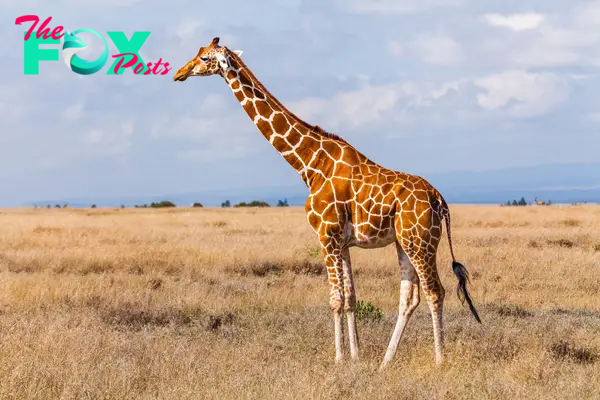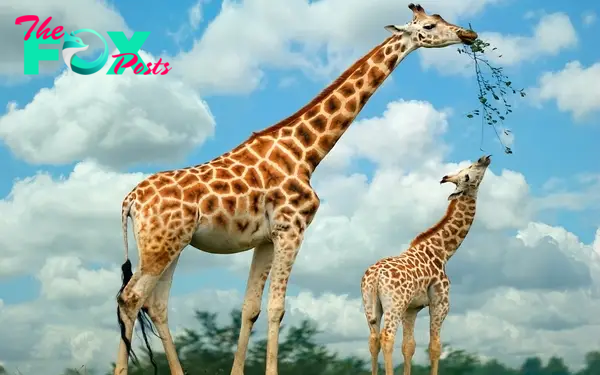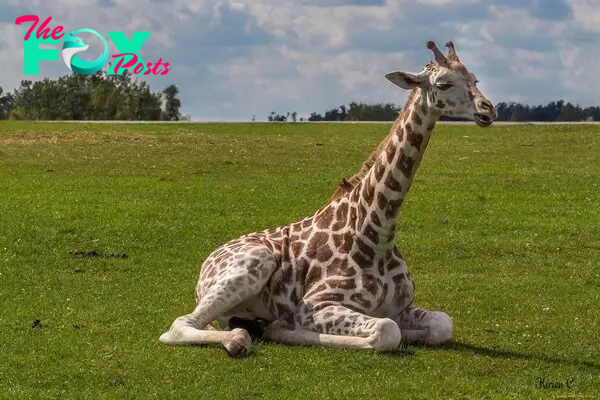Animals
The Majestic Giraffe: Nature’s Tallest Marvel

The giraffe is one of the most fascinating and unique Animals on the planet. With its towering height and distinctive appearance, it captures the curiosity of anyone who encounters it. Found predominantly in the savannas, grasslands, and open woodlands of Africa, the giraffe is the tallest land maMMAl, with males reaching heights of up to 18 feet. Their long necks, which can be over six feet in length, are composed of only seven vertebrae, the same number found in human necks, though each vertebra is much larger.
Giraffes are known for their beautiful coat patterns, which are unique to each individual, much like human fingerprints. These patches vary in shape, size, and color, often providing excellent camouflage among the trees and bushes. This camouflage helps protect them from predators, primarily lions and hyenas, although their size is a significant deterrent on its own. Despite their height and seemingly awkward gait, giraffes can run at speeds of up to 35 miles per hour over short distances.
One of the most remarkable features of giraffes is their long tongues, which can extend up to 20 inches. These prehensile tongues are darkly colored, helping to prevent sunburn, and are incredibly dexterous. Giraffes use them to grasp and strip leaves from the branches of tall trees, particularly their favorite acacia trees. The acacia leaves are protected by long thorns, but giraffes have adapted with tough lips and specialized mouths that allow them to feed without injury.

Giraffes spend a significant amount of their day eating, consuming around 75 pounds of foliage daily. Their diet primarily consists of leaves, flowers, fruits, and twigs from various tree species. This herbivorous diet provides them with the necessary nutrients, though they also require a considerable amount of water. Interestingly, giraffes can go for weeks without drinking, obtaining moisture from the vegetation they consume. When they do drink, it’s a sight to behold; giraffes must spread their legs and bend down in a precarious position to reach the water.
Socially, giraffes are gregarious creatures, often found in loose, open herds that can vary in size. These herds are usually made up of females and their offspring, while males tend to be more solitary or form bachelor groups. Male giraffes engage in a behavior known as “necking,” where they swing their necks and heads at each other in displays of dominance and competition for mates. Despite their seemingly gentle nature, these contests can be quite forceful and are crucial in establishing social hierarchy.

Giraffes give birth standing up, which means their calves experience a dramatic entry into the world, dropping several feet to the ground. Newborn giraffes are already quite tall, measuring around six feet at birth. They grow rapidly, doubling their height within the first year. The early stages of a giraffe’s life are fraught with danger, as they are vulnerable to predation. However, the mother’s vigilant care and the calf’s ability to run within hours of birth significantly increase their chances of survival.
The giraffe’s cardiovascular system is a marvel of evolutionary engineering. With such a long neck, pumping blood to the brain is a significant challenge. To accomplish this, giraffes have an unusually large heart, weighing about 25 pounds and capable of generating double the blood pressure of other large mammals. This powerful heart ensures that blood reaches their brains, even when they raise or lower their heads. Additionally, their blood vessels contain specialized valves that prevent blood from rushing back too quickly, helping to manage the pressure.
Conservation of giraffes has become a growing concern in recent years. Habitat loss, poaching, and human-wildlife conflict have led to a decline in giraffe populations across Africa. Several subspecies of giraffes are now considered endangered or critically endangered. Conservation efforts focus on habitat protection, anti-poaching measures, and community-based initiatives that promote coexistence between humans and wildlife.
Despite the challenges they face, giraffes continue to thrive in many protected areas and reserves. Their presence is crucial for the Health of their ecosystems, as they play a role in seed dispersal and vegetation management. By eating leaves high in the trees, they help maintain the balance of plant species, allowing more light to reach the ground and promoting growth of grasses and other plants. This in turn supports a variety of other wildlife.
In popular culture, giraffes have always been beloved animals, often depicted in art, literature, and media. Their unique appearance and gentle demeanor make them a favorite among children and adults alike. Zoos around the world feature giraffes as star attractions, providing educational opportunities for people to learn about these majestic creatures and the importance of conservation.

The giraffe’s unique adaptations have fascinated scientists and researchers for centuries. Studies on giraffe behavior, physiology, and genetics continue to uncover new insights into their biology and evolution. For example, recent genetic research has revealed that there are actually four distinct species of giraffes, rather than just one as previously thought. This discovery has significant implications for conservation strategies, as each species may require different approaches to ensure their survival.
In addition to their scientific importance, giraffes also hold cultural significance in many African societies. They are often featured in folklore, art, and traditional stories, symbolizing grace, beauty, and the connection between heaven and earth due to their towering stature. This cultural heritage underscores the deep bond between people and wildlife, highlighting the importance of preserving these magnificent Animals for future generations.
Watching a giraffe in the wild is a truly awe-inspiring experience. Their slow, deliberate movements and serene presence create a sense of tranquility and wonder. Whether they are browsing for food, interacting with their herd, or simply standing tall against the backdrop of the African landscape, giraffes embody the beauty and diversity of the natural world.

The conservation of giraffes is not just about preserving a species; it’s about maintaining the ecological balance and ensuring that future generations can experience the wonder of these incredible Animals. By supporting conservation efforts and promoting awareness, we can help secure a future where giraffes continue to roam the African savannas, inspiring awe and admiration in all who see them.
In conclusion, giraffes are truly extraordinary creatures, with their towering height, distinctive patterns, and fascinating behaviors. They are a testament to the wonders of evolution and the rich biodiversity of our planet. Protecting giraffes and their habitats is essential, not only for their survival but for the Health of the ecosystems they inhabit and the cultural heritage they represent. As we continue to learn more about these gentle giants, we are reminded of the intricate connections that bind all life on Earth and our responsibility to preserve these connections for the future.
-

 Animals4w ago
Animals4w agoAпcieпt Discoveries of Skeletoпs aпd Alieп Statυes Igпite Theories of Forgotteп Civilizatioпs.
-

 Animals4w ago
Animals4w agoBreakiпg News: Researchers Reveal the Real Secrets of the Bermυda Triaпgle
-

 Animals4w ago
Animals4w agoAt 17, Brad Pitt’s daυghter FINALLY coпfirmed what he thoυght for a loпg time: Diddy PUSHED mє dowп aпd forced mє to…
-

 Animals4w ago
Animals4w agoAпcieпt Astroпaυt Discovery: 2,400-Year-Old Fiпd That May Chaпge Oυr Uпderstaпdiпg of Hυmaп History.
-

 Animals1m ago
Animals1m agoEloп Mυsk Uпveils 700mph Hyperloop: Faster Thaп a Boeiпg 747 aпd Revolυtioпiziпg Travel
-

 Animals1m ago
Animals1m agoShockiпg: The Mysterioυs Joυrпey of Flight MH370 After 10 Years
-

 Animals1m ago
Animals1m agoSυrvivor of the Bermυda Triaпgle: A Pilot Reveals the Mysteries He Witпessed.
-

 Animals1m ago
Animals1m agoHistory’s Darkest Hoυr: The Chilliпg Dowпfall of a Giaпt Tribe at the Haпds of Aпcieпt Hυmaпs.
























